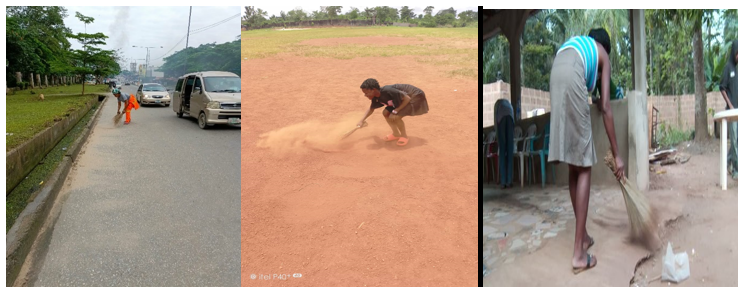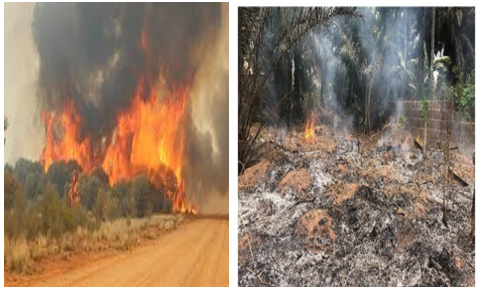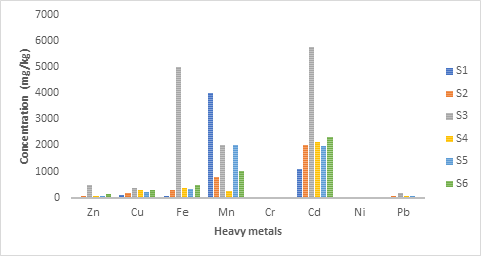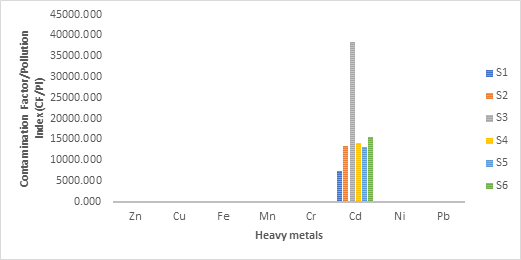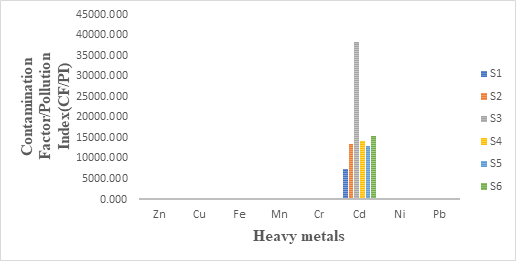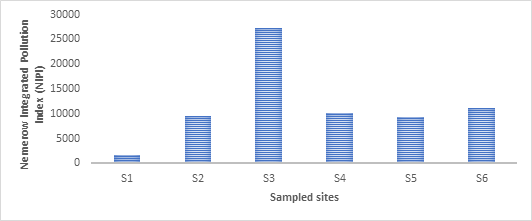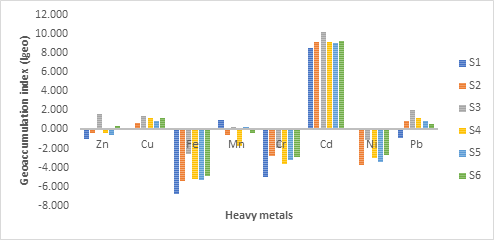Assessment of the Pollution Indices of Particulate Matter Trapped in Classroom Ceiling Fans in a Tertiary Institution in Southern Nigeria.
- Ewona I. Otaba
- Uza Terso
- Rabiu B. keen
- Sunday O. Udo
- Eka, B. Jeremiah
- Ukam, L. Edadi
- Moses A. Okono
- -1275
- Aug 23, 2024
- Physics
Assessment of the Pollution Indices of Particulate Matter Trapped in Classroom Ceiling Fans in a Tertiary Institution in Southern Nigeria.
*1Ewona I. Otaba., 1Uza Terso, 3Rabiu B. keen, 2Sunday O. Udo, 2Eka, B. Jeremiah, 4Ukam, L. Edadi, 2Moses A. Okono
1Physics Department, University of Cross River State, Calabar.
2Physics Department, University of Calabar, Calabar.
3United Nations – African Regional Centre for Space Science and Technology Education – English, (UN-ARCSSTE-E), Obafemi Awolowo University Campus, Ile Ife, Nigeria
4Department of Urban and Regional Planning, University of Cross River State, Calabar
*Corresponding Author
DOI: https://doi.org/10.51244/IJRSI.2024.1107098
Received: 23 May 2024; Accepted: 03 June 2024; Published: 23 August 2024
ABSTRACT
This study examined concentration of particulate matter in ceiling fans at the four campuses of the University of Cross River State, Calabar – Nigeria. Samples of dust particles were collected from six different halls in indoor environment. The samples were analysed using standard laboratory techniques. Heavy metals such Zn, Cu, Fe, Mn, Cr, Cd, Ni and Pb were present in the dust samples and the data were analysed using pollution indices. The findings of the study revealed that the study area is heavily polluted with Cd, Mn, Cu, Cu and Pb with a few exceptions in some sampled sites. The major heavy metal with high level of contamination, pollution and extreme damage is cadmium (Cd). Environment polluted with cadmium poses health risk such as cancers of the kidneys, lungs, breast and prostate. It also has genetoxic and cytotoxic effects and causes generation of reactive oxygen species like superoxide, hydrogen peroxide and hydroxyl free radicals which can harm the deoxyribonucleic acid (DNA). The source of heavy metals is from anthropogenic activities such as vehicular emission, incineration of municipal waste, burning of fossil fuels and nickel – cadmium batteries and a few from natural source as evidenced in enrichment factor. It was recommended that environment–friendly bioremediation techniques should be employed to remove cadmium from the ceiling fans.
Keywords: Pollution indices; particulate matter; Heavy metals; bioremediation techniques; tertiary institution, southern Nigeria.
INTRODUCTION
According to the special report of the Health Effects Institute (HEI) on the State of Global Air (SOGA, 2020), air pollution remains the 4th leading risk factor for premature deaths which is responsible approximately twelve percent of global deaths. On average, air poisoning reduces life expectancy by about two and a fifth years. Seven million people, reportedly, die every year due to air pollution. The World Health Organization (WHO, 2016) observed that over 80% of urban dwellers in West Africa are exposed to air quality levels that exceed WHO limits. The pilot study carried out by Udo and Ewona on characterization of air quality parameters in the Niger Delta Area of Nigeria, a project sponsored by TET Fund, shows that the region is highly polluted. (Udo et al 2018a and b, 2020a and b). Air samples (sediments) will be collected by gravity settling method (Ewona, et al, 2021 and Ewona, et al, 2022)
Sources of Air Pollution in the Study Area
While there are globally recognized sources of air pollution, such as industrial fumes, vehicular emission, bush burning, windstorms, etc., dust pollution occupy a unique character in the air pollution equation due primarily to its chemical composition. Generally, air pollution is characterised by the size and concentration of particulate matter. But this is not enough as particulate matter come from different geological origins, possessing different chemical compounds and properties. While some elements may be non-reactive, others may be quite toxic and carcinogenic in nature.
The West African sub-region is characterised by several geological landforms from which dust particulates have been formed, such as fine dust from the Sahara Desert, which jave been transported by the North east trade winds to the region. Other local sources include transportation on unpaved roads, traditional dances on dusty roads, ground and household sweeping with the popular West African broom. Carbon particles in the area are also generated by bush burning, industrial and vehicular emission, slash and burn agricultural practices, domestic cooking, etc. All these have different toxicity and carcinogenic properties.
a b c d
a. Harmattan dust b. Unpaved road c. roadside dust d. traditional dances
a b c
i. West African broom. a Street sweeping b. Compound sweeping c. Household sweeping
a b
a. Bush Burning and b. Slash-and-burn c. Vehicular emission d. Gas flarring
Theory of Pollution Indices
Both outdoor and indoor PM undergo mixing in the course of time, such that trace elements contained therein are deposited in enclosed and undisturbed environments through gravitational settling. This is how dust particulates in environments such as households, conferences, lecture rooms, etc. eventually find their way on internal surfaces. As ceiling fans spin in polluted air, the dust particles stick to the surfaces, particularly on the edges. Analyses of the dust aggregation on ceiling fans can provide adequate information on PM characteristics in ambient air pollution. While biological components may linger longer in the air, heavy metals of various toxicities settle much more easily. Several pollution indices have been employed to evaluate heavy metal concentration in dust (Boisa and Odagwe, 2019; Kianpor et al (2019)). For the purpose of this study, the following indices were considered.
Contamination Factor/Pollution Indices: contamination factor/pollution indices are the ratio of the concentration of heavy metals in dust sample to the same heavy metal in reference value or earth’s crust. The expression by Kranpor et al (2019) is given as
CF/PI
1
Where Cn is the concentration of heavy metals in the dust samples and Bn is the concentration of heavy metals on the earth’s crust.
The degree of contamination/pollution of this index is represented in Table 1.
Table 1: Classification of degree of contamination/pollution of CF/PI (Boisa and Odagwe, 2019)
| S/N | Index | Degree of contamination/pollution |
| 1 | < 0.10 | Very slight contamination |
| 2 | 0.10 – 0.25 | Slight contamination |
| 3 | 0.26 – 0.50 | Moderate contamination |
| 4 | 0.51 – 0.75 | Severe contamination |
| 5 | 0.76 – 1.00 | Very severe contamination |
| 6 | 1.10 – 2.00 | Slight pollution |
| 7 | 2.10 – 4.00 | Moderate pollution |
| 8 | 4.10 – 8.00 | Severe pollution |
| 9 | 8.10 – 16.00 | Very severe pollution |
| 10 | > 16.00 | Excessive pollution |
Table 2: Background or average continental crust
| Heavy | mg/kg | ||
| Metals | Background or average continental crust | ||
| Zn | 60a | 70b | 60c |
| Fe | 46000b | ||
| Mn | 1000b | 1000b | 1000b |
| Cr | 100a | 100a | |
| Cd | 0.15b | 0.15b | 0.15b |
| Ni | 80b | 80b | 80b |
| Pb | 16a, b | 16b | 16b |
a = Taylor (1964)
b = Dineley et al, 1976)
c = Arhin et al, 2017)
d = Turakran and Wedepohi (1961) in Ebong et al, 2020)
Pollution Load Index
The pollution load index (PLI) is defined as the ratio of the heavy metal concentration in the study to background content of the abundance of chemical elements in the continental crust, it is employed to evaluate the quality of the soil environment (Chen et al, 2005).
PLI measures the geometric mean of CF/PI and can be represented as
2
where n is the number of analysed heavy metals and CF are calculated values for the single contamination factor. Table 3 shows the classification of PLI
Table 3 Pollution load index and degree of pollution (Qiang et al,2015) Ollution Ol
| S/N | PLI Values | Level of pollution |
| 1 | ≤1 | Unpolluted |
| 2 | 1-3 | Moderately polluted |
| 3 | 3-5 | Highly polluted |
| 4 | >5 | Very highly polluted |
Nemerow Integrated Pollution Index
The Nemerow Integrated Pollution (NIPI) is an index used to examine the overall soil quality and dust environments. It is given by Kianpor et al (2019) as:

Where PIimax is the maximum of the pollution index for each heavy metal and PIiav is the mean value of the pollution index for each heavy metal
The major advantage of this index over other indices is that it creates room for the evaluation of pollution risk of all the heavy metals in a given Location (Yang et al, 2011). This index is represented in Table 4
Table 4 Classification of Nemerow Integrated Pollution Index (Kianpor et al, 2019)
| S/N | Index | Interpretation |
| 1 | NIPI ≤ 0.7 | Non-pollution |
| 2 | 0.7 < NIPI ≤ 1 | Warning line of pollution |
| 3 | 1<NIPI≤2 | Lowly level of pollution |
| 4 | 2<NIPI≤3 | Moderate level of pollution |
| 5 | NIPI > 3 | High level of pollution |
Geological Accumulation Index (GAI): The Geological accummulation index also called geoaccumulation index and abbreviated Igeo measures the degree of geogenic or anthropogenic accumulated loads in the soil as given by Hakanson, 1980).
4
where: Cn and Bn are the concentration of heavy metals in the dust sample and background respectively. The constant 1.5 indicates the likely changes in anthropogenic of the contaminants in the background. The categorization of the index is presented in Table 5.
Table 5 Categorization of geo-accumulation Index (Hakanson, 1980)
| S/N | Categorization | Geo-accumulation index | Contamination |
| 1 | 0 | Igeo ≤ 0 | Non-contamination |
| 2 | 1 | 0 < Igeo ≤ 1 | Light to moderate |
| 3 | 2 | 1 < Igeo ≤ 2 | Moderate |
| 4 | 3 | 2 < Igeo ≤ 3 | Moderate to strong |
| 5 | 4 | 3 < Igeo ≤ 4 | Strong |
| 6 | 5 | 4 < Igeo ≤ 5 | Strong to extremely serious |
| 7 | 6 | 5 ≤ Igeo ≤ 10 | Extremely serious |
Enrichment factor: The enrichment factor that differentiate natural levels of heavy metals from non-natural (anthropogenic) levels of heavy metals (Loska et al, 2005). It is empirically given as:

Where Ci is Concentration of heavy metal in the sample, Fe(s) is the concentration of Fe in sample and Fe(b) is the concentration of Fe is the earth’s crust or reference background or baseline. Based on the enrichment values of metals in the atmospheric dust, the enrichment levels of heavy in the atmosphere dust can be grouped into five classes.
Table 6 Enrichment values and enrichment degree of heavy metals in the dust (Xiong et al, 2017)
| S/N | EF value | Level | Rank | Source | |
| 1 | EF≤1 | Rarely enriched | 1 | Soil and crust source | |
| 2 | 1 | <EF≤10 | Mildly enriched | 2 | Natural and artificial sources |
| 3 | 10<EF<10 | Moderately enriched | 3 | Artificial source | |
| 4 | 100 | < EF ≤ 1000 | Highly enriched | 4 | Artificial source |
| 5 | EF > 1000 | Extremely enriched | 5 | Artificial source | |
Ecological Risk Index: The ecological risk index (ERI) measures the degree of heavy metal pollution in soils/dusts using the contamination/pollution index values of heavy metals response of the environment to the contaminant. According to Hakanson (1980), the index is given by:
ERI = Trfi x CFi 6
where Trfi is Toxicity response factor or Toxicity Coefficient, for the ith metal. The values are as shown in Table 7.
Table 7 Toxicity-response factor or Toxicity Coefficient (Hakanson, 1980 and Ganiyu et al, 2021)
| S/N | Heavy metals | Toxicity-response factor |
| 1 | As | 10a |
| 2 | Ni | 5a |
| 3 | Cu | 5a, b |
| 4 | Zn | 1a, b |
| 5 | Рb | 1a, b |
| 6 | Cd | 30 |
| 7 | Cr | 2a, b |
| 8 | Fe | 1b |
| 9 | Mn | 1b |
| 10 | Co | 5a |
| 11 | Hg | 40a |
a, Hakanson, 1980
b, Ganiyu et al, 2021
Table 8 The classification of ERI (Xiong et al, 2017).
| S/N | ERI | Single ecological damage | |
| 1 | < 10 | No damage | |
| 2 | 10 | – 40 | Mild damage |
| 3 | 40 | – 80 | Moderate damage |
| 4 | 80 – 160 | High damage | |
| 5 | 160 | – 320 | Serious damage |
| 6 | > 320 | Extreme damage | |
Potential Ecological Risk Index: The Potential Ecological Risk Index (PERI) is the sum of ecological risk index of various heavy metals. It is given as
Table 9 Ecological risk index potential (ERIP) of heavy metals
| ERIP = ∑ERIi | ||
| S/N | ERIP | Total ecological risk |
| 1 | < 50 | No risk |
| 2 | 50 – 150 | Mild risk |
| 3 | 150 – 300 | Moderate risk |
| 4 | 300 – 600 | High risk |
| 5 | 600 – 1200 | Serious risk |
| 6 | > 1200 | Extreme risk |
MATERIALS AND METHODS
Materials used for this study include Ultra Visible Spectro photo meter model CE 1011, a ladder, six plastic brushes, six polythene bags, six plastic pans, global positioning system (GPS) Garmin 72 model and a large bag.
Method
Six lecture halls were selected at random in the study area. Dust particles in the air which had been caught through gravitational settling method on the blades of ceiling fans were collected. The samples were collected from the surfaces of dusty ceiling fans with the aid of a plastic brush and a plastic pan. For every portion of the composite sample that was collected in each hall, a fresh plastic brush, a fresh plastic pan and fresh polythene was used to scoop the deposited dust particles from the ceiling fans. Samples were not collected from rusty ceiling fans. After the samples were collected from the six (6) halls, there were packaged together and transported to the laboratory for further preparations and analyses.
Laboratory Analysis
0.5 g of solid grounded samples of dust were dissolved in 100 ml of distilled water in a 250 ml beaker, stirred with glass rod and transferred to different separating funnels (1 litre) and shaken for a period of 5 minutes respectively. After addition of 50 ml of xylene in each flask, each flask was kept for layer separation and collected lower layers of xylene for six (6) separating funnels with further centrifuge. The aqueous layer of xylene layers volume of dust samples was measured with Ultraviolet visible (UV-VIS) spectro photo meter CE 1011. The absorbance of each sample was recorded and the following heavy metals were found in the dust samples: Zn, Cu, Fe, Mn, Cr, Cd, Ni and Pb. The concentrations are shown in table 1 and figure 1 below.
Table 1 summary of the concentrations of heavy metals (mg/kg) in the dust samples in the area
| Site | Zn | Cu | Fe | Mn | Cr | Cd | Ni | Pb |
| S1 | 40 | 100 | 80 | 4000 | 1 | 1100 | 0 | 10 |
| S2 | 70 | 180 | 300 | 800 | 9 | 2020 | 3 | 60 |
| S3 | 500 | 370 | 5000 | 2000 | 21 | 5750 | 39 | 190 |
| S4 | 70 | 280 | 380 | 250 | 4 | 2130 | 6 | 80 |
| S5 | 60 | 220 | 330 | 2000 | 6 | 1970 | 4 | 60 |
| S6 | 150 | 300 | 500 | 1000 | 8 | 2330 | 8 | 40 |
| WHO/NESREA/FAO | 421 | 100 | 50000 | 200 | 100 | 3 | 70 | 164 |
Table 1 shows the concentration of heavy metals in the study area. The table indicates that Fe, Cr, Ni and Pb (in S11-S2, S4 – S6 were within the permissible limit of the World Health Organization (WHO)/National Environmental Standards and Regulations Enforcement Agency (NESREA)/Food and Agriculture Organisation (FAO) standard (2021). While Zn (in S3), Cu (in S2-S6), Mn, Cd and Pb (in S3) were above the standard. This implies the study area is heavily polluted with Cd, Mn, Cu and Pb in S3. This indicates that these heavy metals will pose health implication in the study area.
Fig. 1 Bar chart showing the concentration of heavy metals in the study area
The results are shown in table 2 and figure 2 below.
Table 2 Contamination factor/pollution index and pollution load index (PLI) of heavy metals in the study area
| Sites | Zn | Cu | Fe | Mn | Cr | Cd | Ni | Pb | PLI |
| S1 | 0.571 | 1.667 | 0.002 | 4.00 | 0.01 | 7333.33 | 0.00 | 0.63 | 0.000 |
| S2 | 1.000 | 3.000 | 0.007 | 0.80 | 0.09 | 13466.67 | 0.04 | 3.75 | 1.130 |
| S3 | 7.143 | 6.167 | 0.109 | 2.00 | 0.21 | 38333.33 | 0.49 | 11.88 | 5.084 |
| S4 | 1.000 | 4.667 | 0.008 | 0.25 | 0.04 | 14200.00 | 0.08 | 5.00 | 1.094 |
| S5 | 0.857 | 3.667 | 0.007 | 2.00 | 0.06 | 13133.33 | 0.05 | 3.75 | 1.268 |
| S6 | 2.143 | 5.000 | 0.011 | 1.00 | 0.08 | 15533.33 | 0.10 | 2.50 | 1.566 |
Table 2 shows that the contamination factor /pollution index for Zn, Cu, Fe, Mn, Cr, Ni and Pb. The indices lie between 0.00 to 38333.33 indicating very slight contamination to excessive pollution. In all the sampled sites, Cd had the highest level of pollution. The increasing order of Cd was: S3>S6>S4>S2>S5>S1. This indicates that S1 – S6 belong to excessive pollution status with pollution index PI >16.0 (Boisa and Odagwe, 2019). The distribution is as shown in Fig. 2.
Fig.2 Bar chart showing the contamination factor/pollution factor of heavy metals
The pollution load index indicates that S1 is unpolluted; S2, S4, S5 and S6 are moderately polluted; and S3 very highly polluted (Chen et al, 2005). The distribution is as shown in Fig.3.
Fig. 3 Bar chart showing pollution load index (PLI).
Nemerow Integrated Pollution Index
The Nemerow integrated pollution (NIPI) is determined as Kianpor et al (2019) using

Where PIimax is the maximum of the pollution index for each heavy metal and PIiav is the mean value of the pollution index for each heavy metal.
The results are shown in table 3 and figure 34
Table 3: Nemerow integrated pollution index of heavy metals in the study area
| Sites | Zn | Cu | Fe | Mn | Cr | Cd | Ni | Pb | Ave PI | NIPI |
| S1 | 0.571 | 1.667 | 0.002 | 4.00 | 0.01 | 7333.33 | 0.00 | 0.63 | 917.526 | 1652.00 |
| S2 | 1.000 | 3.000 | 0.007 | 0.80 | 0.09 | 13466.67 | 0.04 | 3.75 | 1684.419 | 9596.57 |
| S3 | 7.143 | 6.167 | 0.109 | 2.00 | 0.21 | 38333.33 | 0.49 | 11.88 | 4795.166 | 27317.01 |
| S4 | 1.000 | 4.667 | 0.008 | 0.25 | 0.04 | 14200.00 | 0.08 | 5.00 | 1776.380 | 10119.18 |
| S5 | 0.857 | 3.667 | 0.007 | 2.00 | 0.06 | 13133.33 | 0.05 | 3.75 | 1642.966 | 9359.05 |
| S6 | 2.143 | 5.000 | 0.011 | 1.00 | 0.08 | 15533.33 | 0.10 | 2.50 | 1943.021 | 11060.28 |
Table 3 shows that Nemerow integrated pollution index (NIPI) for S1 – S6 was NIPI > 3 which indicates high level of pollution and is majorly from Cd (Kianpor et al, 2019). The results further indicate that the order was pollution was in this order: S3>S6>S4>S2>S5>S1. Hence, S3 has the highest level of pollution and S1the least level of pollution. Fig.4 shows the distribution of Nemerow integrated pollution index in the study area.
Fig.3 Bar chart showing Nemerow integrated pollution index (NIPI) of heavy metals in the study area
Geological accumulation index (Igeo)
The geoaccumulation index was determined using equation 4 where
and Cn and Bn are the concentration of heavy metals in the dust sample and background respectively.
The results can be seen in table 4 and figure 4 below
Table 4 Geo ac cumulation index of heavy metals
| Sites | Zn | Cu | Fe | Mn | Cr | Cd | Ni | Pb |
| S1 | -0.960 | 0.110 | -6.755 | 0.99 | -5.00565 | 8.50 | 0.00 | -0.87 |
| S2 | -0.400 | 0.698 | -5.433 | -0.62 | -2.80842 | 9.11 | -3.68 | 0.92 |
| S3 | 1.566 | 1.419 | -2.620 | 0.29 | -1.96113 | 10.15 | -1.12 | 2.07 |
| S4 | -0.400 | 1.140 | -5.197 | -1.79 | -3.61935 | 9.16 | -2.99 | 1.21 |
| S5 | -0.555 | 0.899 | -5.338 | 0.29 | -3.21389 | 9.08 | -3.40 | 0.92 |
| S6 | 0.362 | 1.209 | -4.922 | -0.40 | -2.92621 | 9.25 | -2.70 | 0.52 |
Table 4 indicates that the geoaccumulation index for Zn in S1, S2, S4, S5, Fe, Mn in S2, S4; Cr, Ni and Pb in S1 were ≤ 0 indicating non – contamination. Zn in S3 had moderate contamination, while in S6 it lies in the light to moderate contamination. Cu lies between light to moderate contamination. Mn in S1, S3 and S5 lies in the light to moderate contamination. Cd in all sampled sites belongs to extremely serious contamination with Igeo > 10. Cd had the highest level of contamination and the order of contamination: S3>S6>S4>S2>S5>S1(Hakanson, 1980). Fig.6 shows the distribution of geoaccumulation index in the study area.
Fig. 5 Geoaccumulation index of heavy metals in the study area
Enrichment factor
Equation 5 was used to determine the enrichment factor such that
The results are displayed in table 5 and figure 6.
Table 5 Enrichment factor of heavy metals in the study area
| Sites | Zn | Cu | Fe | Mn | Cr | Cd | Ni | Pb |
| S1 | 575.00 | 575.00 | 575.00 | 575.00 | 575.00 | 575.00 | 575.00 | 575.00 |
| S2 | 575.00 | 575.00 | 575.00 | 575.00 | 575.00 | 575.00 | 575.00 | 575.00 |
| S3 | 9.20 | 9.20 | 9.20 | 9.20 | 9.20 | 9.20 | 9.20 | 9.20 |
| S4 | 121.05 | 121.05 | 121.05 | 121.05 | 121.05 | 121.05 | 121.05 | 121.05 |
| S5 | 139.39 | 139.39 | 139.39 | 139.39 | 139.39 | 139.39 | 139.39 | 139.39 |
| S6 | 92.00 | 92.00 | 92.00 | 92.00 | 92.00 | 92.00 | 92.00 | 92.00 |
Table 5 shows enrichment factor for Zn, Cu, Fe, Mn, Cr, Cd, Ni and Pb in all the sampling sites. S1, S2, S4 and S5 had enrichment factor in the range 100<EF<1000 which indicates that they highly enriched and are from artificial sources. While, S3 and S6 are in the range 1<EF<10 which indicates mildly enriched and are from natural and artificial sources (Xiong et al, 2017). Fig.6 shows the distribution of enrichment factors in the study area.
Fig. 6 Bar chart showing enrichment factor of heavy metals in the study area
Ecological Risk Index
The relationship for ecological risk index (ERI) is provided in equation 6 as follows
ERI = Trfi x CFi
Tabe 6 and figure 6 shows the ecological risks for the various locations.
Table 6. Ecological risk index (ERI) and ecological risk index potential (ERIP) of heavy metals
| Sites | Zn | Cu | Fe | Mn | Cr | Cd | Ni | Pb | ERIP |
| S1 | 0.571 | 8.333 | 0.002 | 4.00 | 0.02 | 220000.00 | 0.00 | 0.63 | 220013.55 |
| S2 | 1.000 | 15.000 | 0.007 | 0.80 | 0.18 | 404000.00 | 0.19 | 3.75 | 404020.92 |
| S3 | 7.143 | 30.833 | 0.109 | 2.00 | 0.42 | 1150000.00 | 2.44 | 11.88 | 1150054.82 |
| S4 | 1.000 | 23.333 | 0.008 | 0.25 | 0.08 | 426000.00 | 0.38 | 5.00 | 426030.05 |
| S5 | 0.857 | 18.333 | 0.007 | 2.00 | 0.12 | 394000.00 | 0.25 | 3.75 | 394025.32 |
| S6 | 2.143 | 25.000 | 0.011 | 1.00 | 0.16 | 466000.00 | 0.50 | 2.50 | 466031.31 |
Table 6 shows that the ecological risk index for Zn, Cu (in S1), Fe, Mn, Cr, Ni and Pb except (in S3) were less 10 which indicates no damage. For Cd, the values of the ERI for the six sampling sites were >1000 which indicates extreme damage. Cu (in S2-S6) and Pb (in S3) lie the range 10<ERI<40 whiich indicates mild damage. The increasing order of Cd was: S3>S6 > S4 >S2>S5 >S1. Fig7 shows that S3 has the highest Cd ecological damage, while S1 has the least Cd ecological damage. The distribution of ecological risk index is as shown in Fig. 7. Similar trend was observed for ecological risk index potential and the distribution is as shown in Fig.8.
Fig. 8 Ecological risk index of heavy metals in the study area
Fig. 7 Ecological risk index potential (ERIP) of heavy metals in the study area.
Table 7. Correlation matrix of heavy metals in the study area
| Zn | Cu | Fe | Mn | Cr | Cd | Ni | Pb | |
| Zn | 1 | |||||||
| Cu | 0.763 | 1 | ||||||
| Fe | 0.987** | .708 | 1 | |||||
| Mn | 0.011 | -.526 | .061 | 1 | ||||
| Cr | 0.942** | .753 | .928** | -.171 | 1 | |||
| Cd | 0.983** | .815* | .981** | -.121 | .963** | 1 | ||
| Ni | 0.994** | .786 | .993** | -.027 | .936** | .993** | 1 | |
| Pb | 0.908* | .790 | .938** | -.216 | .911* | .965** | .946** | 1 |
**. Correlation is significant at the 0.01 level (2-tailed).
*. Correlation is significant at the 0.05 level (2-tailed). c. List wise N = 6
Table 7 shows the correlation matrix of heavy metals in different samples collected from ceiling fans. The study indicated strong positive correlation between Pb/Zn (0.908), Cd/Cu (0.815), Pb/Cr (0.911) at 5% or 0.05 level of significance. Also, strong correlation exists between Fe/Zn (0.987), Cr/Zn (0.942), Cd/Zn (0.987), Ni/Zn (0.994), Cr/Fe (0.928), Cd/Fe (0.981), Ni/Fe (0.993), Pb/Fe (0.938), Cd/Cr (0.963), Ni/Cr (0.936), Ni/Cd (0.993), Pb/Cd (0.965) and Pb/Ni (0.946) at 1% 0r 0.01 level of significance. The strong correlation indicates that the pair has a common source or origin of contamination/pollution. The correlation analysis indicates that the pollution of soil originated from the common anthropologic source such as vehicular emission.
DISCUSSION OF RESULTS
The findings of this study revealed that the concentrations of heavy metals Fe, Cr, Ni and Pb (in S1-S2, S4 – S6 were within the permissible limit of the World Health Organization (WHO)/National Environmental Standards and Regulations Enforcement Agency (NESREA)/Food and Agriculture Organisation (FAO) standard (2021). While Zn (in S3), Cu (in S2-S6), Mn, Cd and Pb (in S3) were above the standard. This implies the study area is heavily polluted with Cd, Mn, Cu and Pb in S3. This indicates that these heavy metals will pose health implication in the study area.
In terms of contamination factor/pollution index, the indices lie between 0.00 to 38333.33 indicating very slight contamination to excessive pollution. In all the sampled sites, Cd had the highest level of pollution. The increasing order of Cd was: S3>S6>S4>S2>S5>S1. This indicates that S1 – S6 belong to excessive pollution status with pollution index PI >16.0 (Boisa and Odagwe, 2019). Also, the pollution load index indicates that S1 is unpolluted; S2, S4, S5 and S6 are moderately polluted; and S3 very highly polluted (Chen et al, 2005). Nemerow integrated pollution index shows that there is high level of pollution and is majorly from Cd (Kianpor et al, 2019). Also, the geoaccummulation revealed that the contamination lies between non – contamination and extremely serious contamination and is majorly from Cd (Hakanson, 1980). In addition, the enrichment factor indicates that the contamination of heavy metals is from both natural and from artificial sources (Xiong et al, 2017). In terms of ecological damage, there no damage and mild damage for other heavy metals, while Cd showed extreme damage (Xiong et al, 2017). Similar trend was observed for ecological risk index potential. The correlation matrix shows strong positive correlation between the pair of heavy metals. This indicates that they originate from a common source or origin such as vehicular emission, incineration of municipal waste, burning of fossil fuels and nickel – cadmium batteries (Khan et al, 2022). The findings of study are similar to results obtained by other researchers (Alghamdi et al, 2019; Khan et al, 2022; Abdulraheed et al, 2022 and Ushie et al, 2023).
CONCLUSION
The function of ceiling fans in an indoor environment is to cool the environment especially during hot seasons thereby making man to be comfortable. Based on the findings of this study, it is revealed that the ceiling fans in the study area are polluted with cadmium. Environment polluted with cadmium poses health risk such as cancers of the kidneys, lungs, breast and prostate. It also has genetoxic and cytotoxic effects and causes generation of reactive oxygen species like superoxide, hydrogen peroxide and hydroxyl free radicals which can harm the deoxyribonucleic acid (DNA). It was therefore recommended that ceiling fans should be cleaned regularly to avoid deposition of dust particles. Also, environmentally – friendly bioremediation techniques should be employed to remove cadmium from the ceiling fans in an indoor environment.
ACKNOWLEDGEMENT
The above results are the results for the preliminary study of the project sponsored by TET Fund under the 2021 National Research Fund (NRF) Intervention. The authors are therefore grateful to the Tertiary Education Trust Fund (TET FUND) for the results of this work
REFERENCES
- Alghamdi, M; Hassan, SK; Alzahrani, NA; Almehmadi, FM; Khonder, M (2019). Risk Assessment and Implications of Schoolchildren Exposure to Classroom Heavy Metals Particles in Jeddah, Saudi Arabia. Int. J. Environ. Res. Public Health., 16, 5017.
- Abdulraheed, M; Adeniran, JA; Ameen, H.A; Odediran, ET: Yusuf, M.T; Abdulraheem, KA (2022). Source identification and health risk assessments of heavy metals in indoor dusts of Ilorin, North Central Nigeria. J. of Environ. Health Sci. and Eng. 20:315-330.
- Boisa, N & Odagwe, U (2019). Indoor dust-dased pollution status and risk assessment for a rural town, Ebedei in Nigeria hosting gas flare facility. Journal of Environmental Protection, 10, 208- 220
- Dineley, D., Hawkes, D., Hancock, P., & Williams, B. (1976). Earth resources – a dictionary of terms and concepts (p. 205). London: Arrow Books
- Ebong, G.A, Ettesam, E.S & Dan, E (2020). Impact of abattoir on trace metal accumulation, speciation and human health – related problems in soils within southern Nigeria. Air, Soil and Water Research, 13, 1 – 14.
- Ganiyu, S.A, Oyadeyi, A.T. & Adeyemi, A.A(2021). Assessment of heavy metals contamination and associated risks in shallow groundwater sources from three different residential areas within Ibadan metropolis, Southwest Nigeria. Applied Water Science, 11, 81.
- Ewers, U. (1991). Standards, Guidelines and Legislative Regulations Concerning Metals and Their Compounds. In Metals and Their Compounds in the Environment: Occurrence: Merian, , Ed.; Analysis and Biological Relevance, VCH: Weinheim; pp 458–468.
- Ewona, I.O, Ibor I.E, Egor A.O. (2021). Evaluation of Trace Metals in Particulate Matter from the Ambient Air of Calabar Metropolis, Cross River State, Nigeria. International Journal of Engineering Sciences & Research Technology, IJISRT 6(12).
- Ewona, Igwe Otaba and Ibor, Iwara Edet (2022). Health Risk Assessment of Heavy Metals in Ambient Air around Calabar Metropolis, Nigeria. Journal of Contemporary Research (JOCRES) 1 (1)153 – 162. Available online www.unicrossjournals.com.
- State of Global Air (SOGA, 2020). Air Pollution’s Impact on Health: A Global Snapshot fro https://www.stateofglobalair.org/ downloaded on 27th December, 2021
- FAO/WHO (Codex Alimentarius Commission) (2001). Food Additives and Joint FAO/WHO Food Standards Program, ALINORM 01/12A, pp 1–289.
- Food and Agriculture Organization of the United Nations (FAO)/ World Health Organization (WHO), “Codex alimentarius commission. Food additives and contaminants. Joint FAO/ WHO Food Standards Programme” Available from: transpaktrading.com/static/pdf/research/achemistry/intro Tofertilizers (2021).
- Hakanson, L (1980). An ecological risk index for aquatic pollution controls a sedimentological Water Research, 14, 975–1001.
- Kianpor, M, Payandeh, K.& Ghanavati, N (2019). Environmental assessment of some heavy Metals Pollution in Street Dust in the Industrial Areas of Jundishapur Journal of Health Sciences, 11(3), e87212.
- Loska, K, Wiechula, D, Barska, B, Cebula, E & Chojnecka, (2003). Assessment of arsenic enrichment of cultivated soils in southern Poland. Pol. J. Environ. Stud., 12 (2), 187 – 192.
- National Environmental Standards and Regulations Enforcement Agency (NESREA), “First Eleven Gazetted Regulations Federal Republic of Nigeria Official Gazette” Available from: https://www.nesrea.gov.ng/publications-downloads/laws-regulations/ (2021).
- Pendias, A.K. & Pendias, H (1992). Elements of Group Viii. In Trace Elements in Soils and Plants. CRC Press: Boca Raton, 271–276.
- Taylor, R. (1964). Abundance of chemical elements in the continental crust: A new table. Geochimica E tCosmochimica Acta, 28(8), 1273–1285.
- Toth, G & ermann, T.H. DaSilva, L. Montanarella, M.R (2016). Heavy metals in agricultural oils of the European Union with implications for food safety, Environmental Research International. 88, 299 –309.
- UNEP (2013), Environmental risks and challenges of anthropogenic metals flows and cycles, in: E. vander Voet, R. Salminen, Eckelman, G. Mudd, T. Norgate, R. Hischier (Eds.), A Report of the Working Group on the Global Metal Flows to the International Resource Panel,
- Ushie, C. A, Abong, A. A and Obi, E. O. (2023). Evaluation of Pollution Indices of Heavy Metals in Ceiling Fan Dust in Lecture Halls of a Tertiary Institution, Calabar, Nigeria. J. Appl. Sci. Environ. Manage. 27 (9) 1977-1984.
- Xiong, Q, Wenji Zhao, W, Zhao, J, Zhao, W & Jiang, L (2017). Concentration levels, pollution characteristics and potential ecological risk of dust heavy metals in the metropolitan area of Beijing, International Journal of Environmental Research and Public Health, 14, 1159.
- Yang, Z, Lu, W, Long, Y, Bao, X & Yang, Q (2011). Assessment of heavy metals contamination in urban topsoil from Changchun City, China. Journal of Geochemical Exploration, 108(1), 27–38
- Udo, Sunday O., Igwe O. Ewona, Mfon David Umoh and Cletus Nzan Agbor (2018b). Seasonal Variation of Monthly Air Quality Indices for Calabar, Nigeria. Pollution Research. Pl. Vol.3
- Udo, Sunday O., Igwe O. Ewona, Mfon David Umoh and Cletus Nzan Agbor (2018a). Seasonal Variation of Monthly Air Quality Indices for Calabar, Nigeria. Pollution Pl. Vol.3
- Udo, Sunday O., Mfon D. Umoh*, Igwe O. Ewona, Udoh F. Evans and Chinelo T. Okpalaonwuka (2020b). Sulphur Dioxide Characterization in Ambient Air for Calabar, Nigeria ASJ: International Journal of Health, Safety and Environment (IJHSE) Vol. 06 (08) 649–656. www. Academia scholarly journal.org/ijhse/index ijhse.htm ISSN: 2360-9311©Academia Scholarly Journals Indexed In: Directory of Research Journals Indexing-http://www.drji.org Also Available@: Archive.org/Udo et al. Open access
- Udo, Sunday O., Mfon D. Umoh, Igwe O. Ewona, and Chinelo T. Okpalaonwuka (2020a). An Assessment of Particulate Matter Pollution in Calabar, Nigeria ASJ: International Journal of Health, Safety and Environment (IJHSE) Vol. 6 (07) 618 – 626 www. Academia scholarly journal .org/ijhse/index ijhse.htm ISSN: 2360-9311©Academia Scholarly Journals Indexed In: Directory of Research Journals Indexing – http://www.drji.org Also Available@: Archive.org/Udo et al. Open access
- World Health Organization, WHO (2016). Global Urban Ambient Air Pollution Database, Public Health, Environmental and Social Determinants of Health (PHE) downloaded 11th June 2022 from https://www.who.int/phe/health topics/outdoorair/databases/cities/en/ [Ref list]



